For a time, not so long ago, our columns have offered more or less consecutively quite a few testing grounds of small Asian digital amplifiers, and in particular the FDA (Full Digital Amplifiers) which usually don’t possess any analog input.
These devices became rarer over time in our columns, and we’ll reacquaint ourselves with the switching amplification by analyzing in all its details the AD18 model from the Chinese brand S.M.S.L. and by giving it a listening review.
This AD18 amplifier isn’t a FDA but is equipped with both analog and digital inputs (among which an aptX Bluetooth connection) and possesses a NFC contactless peering and a headphone jack. It also encourages emulation among the competition, leading other manufacturers to work day and night to create AD18 killers!
Presentation
No platitude for the black anodized all-aluminum box of the AD18 amplifier, and this is a presentation where height has been valued over width.
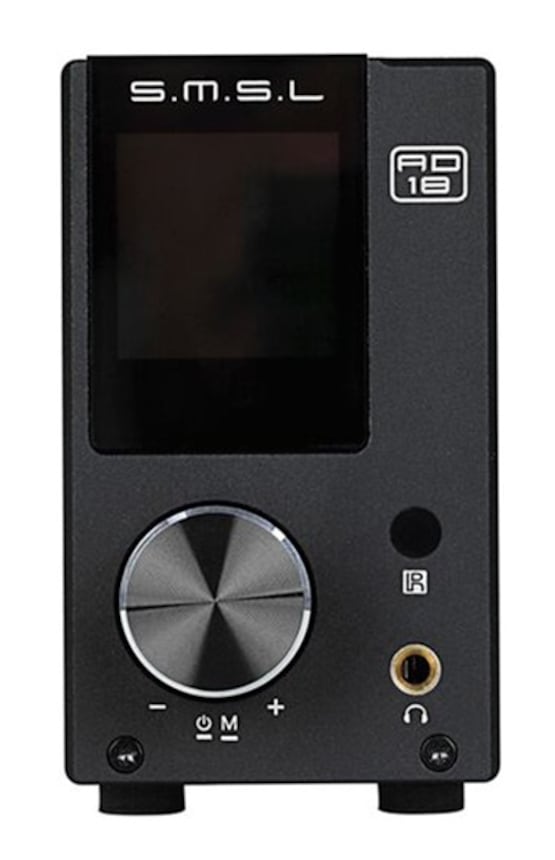
For our part, we find its appearance rather nice and novel with a display located on the top part of the facade, clearly legible (at a reasonable distance) and offering a choice of six colors for the characters, a multifunctional controller (on and off, source selection, access to the menus and navigation), and a gold-plated 3.5mm Headphone Jack. All these functionalities are also available from your couch with the very nice and esthetically pleasing metal remote.
The connectivity isn’t lacking, with a 3.5mm analog stereo input; a micro USB input for a computer, a tablet or a smartphone, compatible up to 24-bit/96 kHz on PC; a 3.5mm Jack S/PDIF input combining electrical and optical, and another one on a Toslink optical plug. The 160 W power supply will be plugged to the corresponding socket. The speaker connectors are rather small insulated models that accept banana plugs, as well as bare wires of a reasonable size.
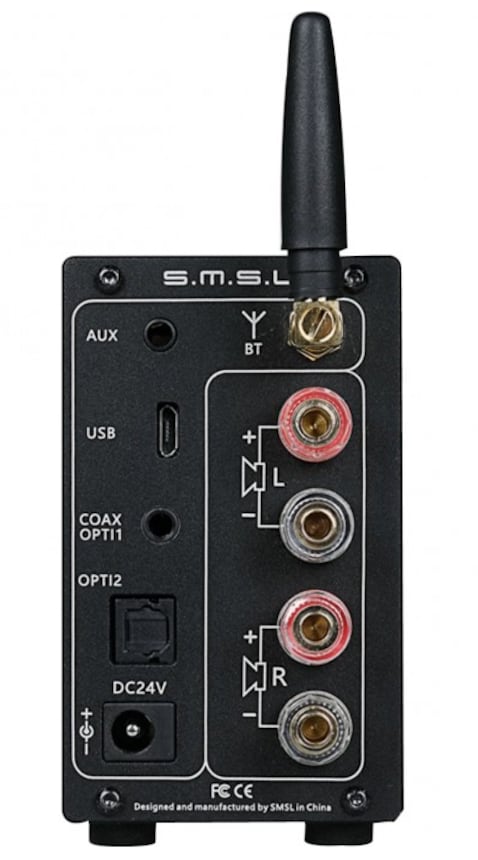
Manufacturing
Aside from the display and the NFC peering card, the electronics of the AD18 are gathered on a double-sided circuit board. On one of these sides, you’ll find the connectors, the USB processor (VIA Technologies VT1620A accepting up to 24-bit/96 kHz), a Cirrus Logic CS8422 S/PDIF receiver (24-bit/192 kHz), a Maxim MAX97220 headphone amplifier and a Texas Instruments TAS5508 audio PWM processor.
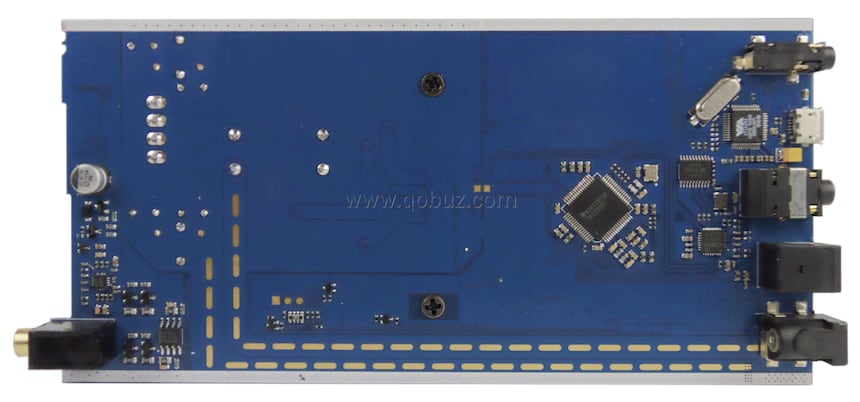
This TAS5508 drives a Texas Instruments TAS5342A module that includes, among other things, switching transistors and can deliver up to 2 x 100 W/4Ω or 2 x 65 W/8Ω (its cooler has been removed for the picture below).
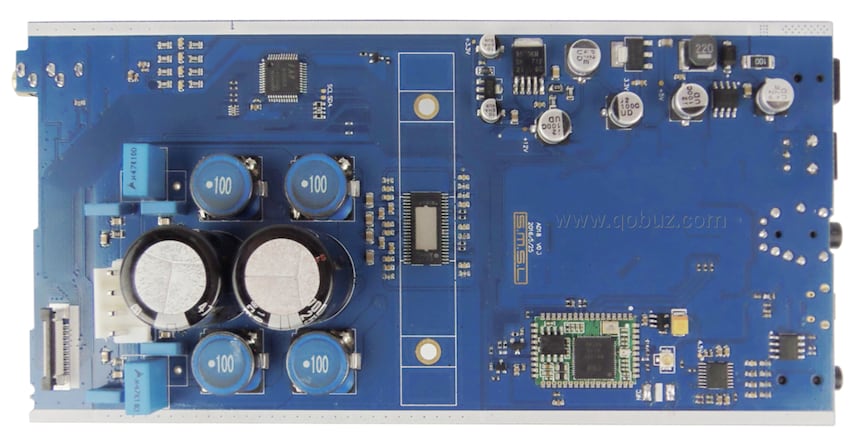
The formatting of the PWM signals coming from the TAS5342A is handled by very complex cells that include electromagnetic coils and many capacitors, ceramic-layered and plastic-layered; it seems much better for sound quality than the use of basic filter cells from electrochemical capacitors.
Two 4700 μF/25V Panasonic XC capacitors of this type are located on the supply line from the power pack, as close as possible to the TAS5342A in order to ensure it a strong current reserve, these capacitors being mounted in parallel.
On the left side, at the bottom, you’ll find a 3.3 V AMS1117 3.3 regulator, while at the top you’ll see a Cirrus Logic CS5341 digital-to-analog converter which digitizes to 24-bit resolution the analog signals coming from the auxiliary input, as well as the Qualcomm Bluetooth module equipped with a CSRA64215 chip, which is aptX compatible.
Sound For sure, this small S.M.S.L. AD18 amplifier with DAC is a prodigy, and you don’t have to listen to it for hours to realize the high quality of the sound restitution it offers: you’ll know in just a few seconds! We also took care to remove all processing, such as the bass and treble corrections, and the equalization.
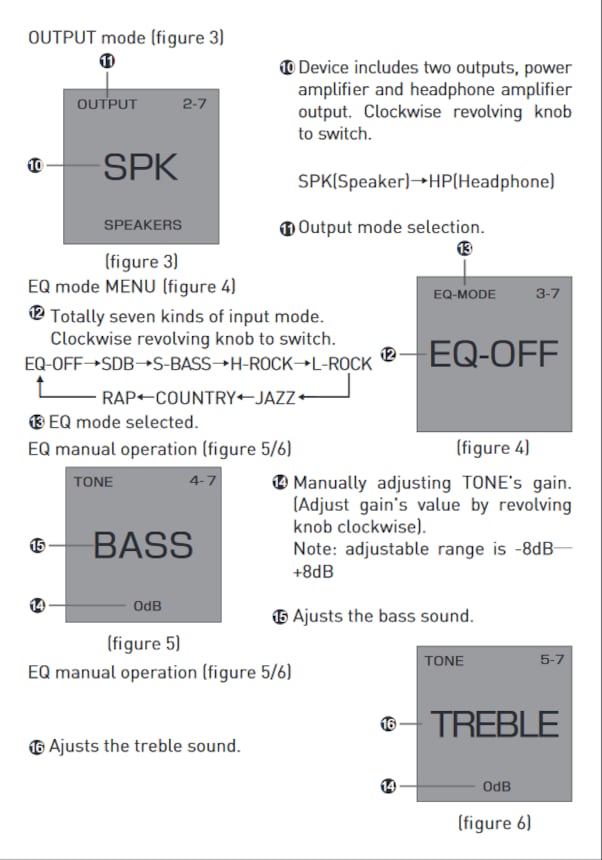
We also appreciated the progressiveness of the volume setting, allowing you to precisely adapt the sound volume without it being too high in the first levels and making it very hard, or even impossible, to find the right setting. It’s a very good thing in its favor, then.
We’re thus seized by happiness from the first measures of Vivaldi’s Vespri per l'Assunzione di Maria Vergine by Rinaldo Alessandrini conducting the Concerto Italiano, listened on Qobuz Desktop on PC. To think that such a beautiful sound comes out of such a little box boggles the mind.
Of this title, the S.M.S.L. AD18 offers a restitution where the music is treated with the utmost respect, and this, even when you turn up the volume; the electronics keep away from harshness at the top of the spectrum, especially when the soprano indulges in vehemence, while its vivacity lends itself perfectly to the chord attacks and we can relish in the large range of colors, among which the glorious sounding brass instruments from the Allegro of the Dixit Dominus.
In short, once again, the switching amplification proves its maturity, and maybe this time it’s S.M.S.L. which shows all of its, let’s say it, exceptional know-how on the subject with this AD18.
Let’s go from the divine glory magnified by Vivaldi’s light to the dark beauty of Leonard Cohen’s testament album You Want It Darker, reproduced with all the strength and dark depth of the voice and music from the Canadian singer, who brings us into his last musical wake, highlighted with style by the S.M.S.L. AD18.
As for its bass performance, there’s nothing to add. It hits hard even at low volume with the title North Star from Tale Of Us, and even becomes unbearable when you turn up the volume, and this without losing any clarity or stability.
As a final note, it’s worth mentioning that we had no difficulty pairing this amplifier in Bluetooth to an Android smartphone compatible with aptX, with excellent sound results; the same goes for the headphone jack—it would have been a shame if the latter had tarnished, even punctually, such a beautiful picture.
To conclude, and without having the pretense to blindly trust our auditory memory, it seems that this S.M.S.L. AD18 is the best switching amplifier that we’ve ever listened to. In any case, it’s a prodigy offering a sound quality of the highest level, and a strong enough power to be easily commanded thanks to a volume control whose flexibility and progressiveness we enjoyed. It’s a device that we would like to congratulate and we bestow it our Qobuzism award!!
User Manual (in English)
We would like to thank Audiophonics for lending us the S.M.S.L. AD18.
To follow everything that happens on Qobuz, join us on Facebook!
If you are a manufacturer, importer, retailer or key player in the digital music industry and wish to contact us, you can do it through the following email address: newstech@qobuz.com
If you’re enthusiastic about the Hi-Fi Guide column and wish to contact us, you can do it through the following email address: rubriquehifi@qobuz.com


